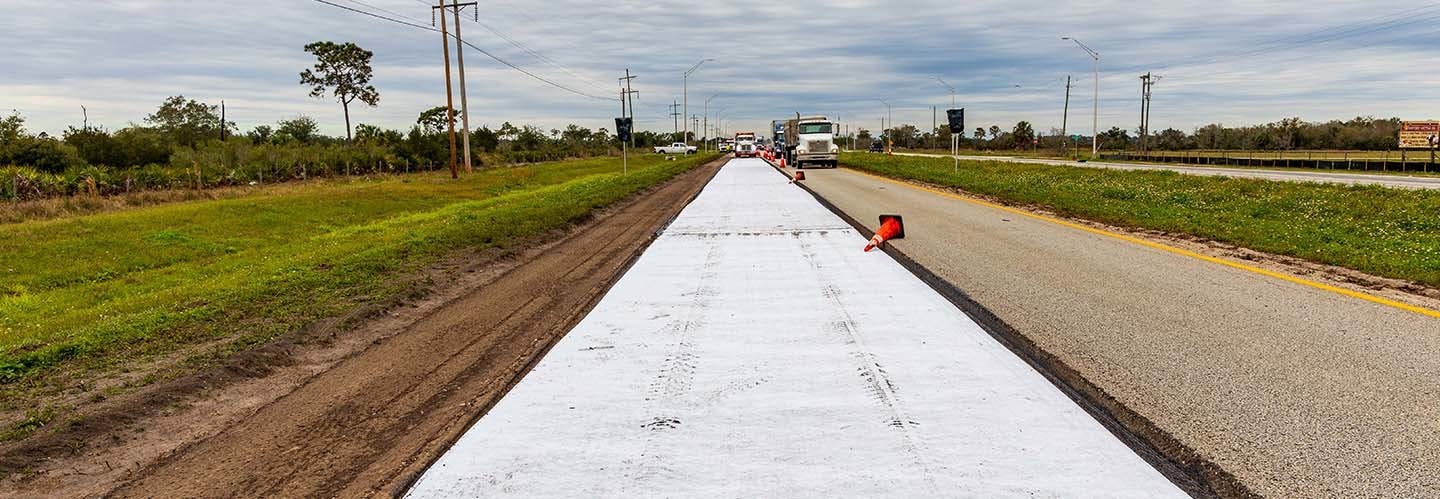Can a structural number be assigned to PETROMAT Paving Interlayers?
Posted on 8.17.2021 by Mark Marienfeld, P.E.
Propex is often asked if PETROMAT® and PETROMAT Enviro can be assigned a structural number as an increased structural contribution to pavements. For reference, structural number (SN) is an AASHTO pavement design index providing an indication of the strength of the pavement layers and of the total pavement structure.
The short answer is, no geosynthetic interlayer may be assigned a structural number as direct pavement support since none are inherently structural layers. However, some geosynthetic interlayers will increase the structural number of other pavement support layers and thereby increase the entire pavement SN to allow additional years of traffic loading.
Research conducted by the Transportation Research Board confirmed that the inclusion of PETROMAT paving interlayer provides an effective moisture barrier in the pavement. By inhibiting moisture infiltration through the pavement surface, the moisture content will be decreased in all of the pavement support layers beneath the paving interlayer. As moisture content in the supporting subgrade soil is decreased, bearing capacity improves. This improvement generally returns the pavement to its original design bearing capacity or better.
The PETROMAT moisture barrier will stop subgrade saturation, pumping, and erosion that may occur. Additionally, if there is an unbound aggregate base supporting the pavement, its moisture level will be maintained at a fully drained condition for permanent assignment of its greatest structural number.
New pavements built using PETROMAT paving interlayer will experience these structural benefits from day one. Existing pavements can recapture these structure benefits by including PETROMAT in their rehabilitated pavement design.
If a moisture barrier like PETROMAT is in place, the base and subgrade will never become saturated to the point where pore pressure can build up under traffic loading to override structural support and cause premature pavement failure. Based on AASHTO 93 pavement design, the more free-draining the unbound aggregate base, the higher the structural strength that may be assigned to that base layer. Commonly a tight, poorly draining aggregate base is used due to its lower cost and ease of compaction. However, this design’s minimal drainage forces designers to assign it a low structural number, which then requires more layer thickness. The structural number of these tight aggregate layers may be doubled if a pavement moisture barrier such as PETROMAT is employed. In this way, PETROMAT can indirectly increase the structural number of pavement support layers.
In addition, minimizing the moisture content of pavement support layers can eliminate freeze/thaw pavement problems. The paving interlayer can also maintain a constant low moisture content in underlying subgrade soils. This enables areas with problematic shrink/swell soils to rendered these soils inactive, and stop their pavement destruction.
The ingress of surface water causes stripping of underlying asphalt concrete layers. As the water sits in the old layers, traffic can cause pore pressure to build and strip away the asphalt cementing media. As these old layers progressively weaken and crumble, a lower structural number must be assigned. The inclusion of PETROMAT over older pavements will stop the progression of this stripping, and the associated loss of structural number.
Unlike other traditional pavement sealing layers like chip seal surface treatments, PETROMAT has been proven to maintain its moisture barrier integrity even if the pavement surface cracks. Traditional seal coats lack the fibrous reinforcement of a paving fabric and will readily split apart, thus losing their effectiveness as a moisture barrier. Geosynthetic pavement interlayers like fiberglass-based paving mats, geogrids without a paving fabric composite, and grid composites that use thin carrier fabrics, do not provide the same degree of moisture protection as PETROMAT. These interlayers either use no asphalt cement tack coat or very little, which is difficult to correctly apply. Additionally, these solutions will readily split apart when the pavement cracks, losing their moisture barrier functionality.
In summary, even though PETROMAT is not inherently a structural layer, it can help increase the overall structural number for the pavement by increasing the bearing capacity of the base, subbase, and subgrade pavement support layers.
Interested in PFAS-Free Plastics?

